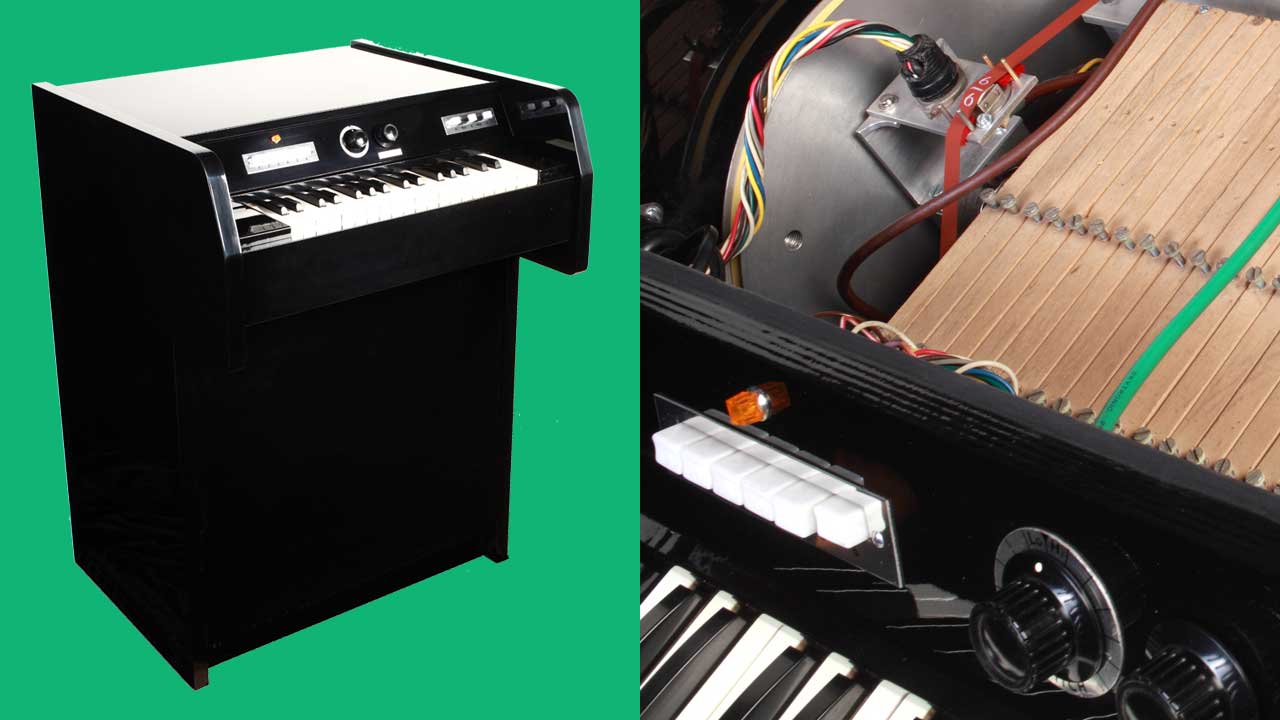
Bulky, heavy, ugly and decidedly unsexy to look at it might have been (especially the early models), but the Mellotron carved out its own niche in the progressive rock scene in the late 60s and early 70s, to the extent that it arguably became the signature sound in the genre, used extensively and popularised by the likes of Genesis, Yes, King Crimson, Barclay James Harvest, Pink Floyd, the Moody Blues, Focus, Tangerine Dream and countless other prog bands.
Manufactured in Birmingham, beginning in the mid-60s, the Mellotron is a keyboard instrument that works by playing tapes of pre-recorded sounds, the tapes driven across tape heads by motors triggered by pressing keys on the keyboard. Imagine a bank of tape machines, with the ‘play’ button of each linked individually to the keys of a keyboard. Effectively, the Mellotron was the first sampler.
As with a tape recorder, any sounds could be pre-recorded onto the Mellotron’s tapes and ‘played’, but it was the factory-loaded ‘orchestral’ sounds that the instrument became known for, and which defined it.
Pressing just one key of a Mellotron doesn’t sound either impressive or particularly ‘orchestral’, but hold down a big chord and the huge, fat, textured, unique sound produced is like some heavenly harmony of the spheres, quite unlike anything else – perfect for the prog merchants looking for an otherworldly sound in which to drape their often equally lofty, bombastic, epic musical ideas.
Although the sound of the Mellotron became a huge part of prog it has also been used – albeit in far smaller doses – by bands right across the musical spectrum, including the Rolling Stones, The Beatles, Led Zeppelin, David Bowie and Lynyrd Skynyrd.
Having largely gone out of favour after prog’s golden era, there has also been a revival in its use in recent years, with Radiohead, Porcupine Tree, Nine Inch Nails, REM and Opeth rediscovering its unique and evocative sound.
The following tracks demonstrate some of the best uses of the Mellotron.

Focus - Le Clochard (Moving Waves, 1971)
Sumptuous use of the Mellotron on an equally sumptuous chord sequence, creating a huge, highly evocative orchestral/choir backdrop on which Jan Akkerman paints some stunning guitar work.
Genesis - Watcher Of The Skies (Genesis Live, 1973)
Any one of a number of Genesis tracks demonstrate the band’s textbook use of Mellotron: put together its big, fat sound, a great song, lush chords and an evocative melody and you have the sound of prog personified.
Gracious! - The Dream (Gracious!, 1970)
A relatively unknown band and track compared to the others here, from a surprisingly unsung 70s prog band who used Mellotron excellently to punctuate this 16-minute epic in particular with some majestic sounds.
King Crimson - The Court Of The Crimson King (In The Court Of The Crimson King, 1969)
Awash with Mellotron, but with a more aggressive, more ‘grimy’ sound than usual, this is one of the all-time classic Mellotron tracks, from one of the pioneering users of the instrument, and showed the rest how to get the best out of it.
The Moody Blues - Nights In White Satin (Days of Future Passed, 1967)
One of the earliest tracks to feature heavy use of Mellotron, and still a stunning demonstration of the instrument’s evocative power when applied to a great, classic chord sequence and a soaring melody.
Radiohead - Exit Music (For A Film) (OK Computer, 1997)
Subtle use of Mellotron rather than awash with it, but the instrument is a key element in the wonderfully spacious, panoramic sound of this track.







